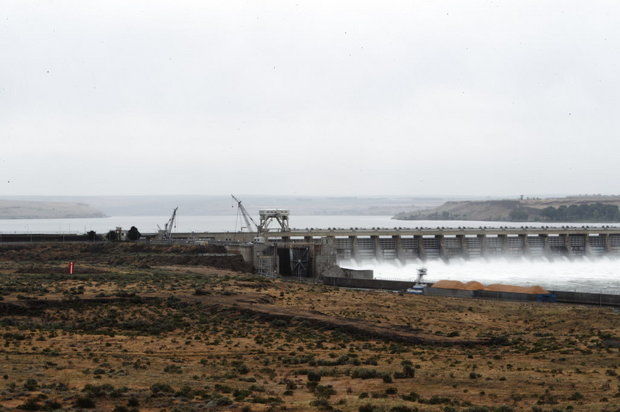forum
library
tutorial
contact

Flows Increased at McNary to
Move Fish Through Columbia Dams
by Staff
Columbia Basin Bulletin, May 22, 2015
|
the film forum library tutorial contact |

|
Flows Increased at McNary to
by Staff
|
No More Dworshak Water Available
 Calling on more water from Grand Coulee Dam, fisheries managers increased the average river flow objective at McNary Dam today (Friday, May 22) from 180,000 cubic feet per second to 210 kcfs for 10 days as a way to assist juvenile salmon past downstream Columbia River dams.
Calling on more water from Grand Coulee Dam, fisheries managers increased the average river flow objective at McNary Dam today (Friday, May 22) from 180,000 cubic feet per second to 210 kcfs for 10 days as a way to assist juvenile salmon past downstream Columbia River dams.
The 210 kcfs flow objective will remain in place through the end of May as long as the extra water doesn't drop Lake Roosevelt's surface elevation below 1,248 feet, which would threaten the reservoir's chance of refilling in June. Its current elevation is 1,248.9 feet.
The Technical Management Team, a regional team of fishery managers and hydroelectric dam operators, approved the operation Wednesday, May 20, at its weekly meeting.
"You recognize that providing this flow for the rest of May will impact refill time?" asked the Bonneville Power Administration's Tony Norris. "The 1,248 (referring to the minimum Lake Roosevelt elevation) is a hedge against a low inflow outcome in May."
"Yes, we know we're borrowing from the future," said Paul Wagner of NOAA Fisheries.
The Bureau of Reclamation's Mary Mellema said that if there is any additional water that could provide for more than an average 210 kcfs flow at McNary Dam, that water instead would be used to refill the reservoir. Flows in June, she added, are variable and all that water will be targeted for refill.
Managers are running out of ways to add water to the river system in order to move the last of the juvenile salmon through the dams. A special operation that released a pulse of water from Idaho's Dworshak Dam into the Lower Snake River ended Tuesday, May 19, when the dam's outflow dropped to a minimum flow of 1.7 kcfs.
That operation began May 16 when Dworshak increased flows from the minimum flow to 5 kcfs, rising to 7.5 kcfs on May 17, dropping back to 5 kcfs May 18, and back to minimum flow May 19, where it will stay while the Dworshak reservoir refills. Water from Dworshak is no longer available for fish flows, at least until refill is complete, sometime between June 5 and June 20, according to Steve Hall of the U.S. Army Corps of Engineers.
Nearly 550,000 yearling chinook salmon have passed Lower Granite Dam on the Snake River in the last 14 days. Year to date, passage of the yearling fish is 1,748,020 (as of May 20). The highest daily passage of the yearling chinook was nearly 112,000 fish on May 8. That was at the height of the first pulse of water from Dworshak when the dam was releasing 9.5 kcfs of water. That flow declined to 5 kcfs on May 9 and to minimum flow May 10.
Yearling chinook passage at Lower Granite Dam dropped May 11 to 31,802 fish, 34,044 May 12, 26,464 May 13, 30,777 May 14, and about 16,000 fish May 15. Since then, yearling chinook passage was in the 8,000 per day range even with the May 16 to 18 pulse of water from Dworshak. As of May 20, the count was at 4,275 fish per day.
Subyearling passage at Lower Granite so far this year is 26,216 fish. Juvenile coho salmon passage is 33,688 fish. Steelhead is 1,172,120. Sockeye is 14,802 and 10 Lamprey have passed the dam.
With the juvenile run winding down in the Snake River and without more Dworshak water, TMT is concentrating on passing juveniles through the lower Columbia River dams by calling on Grand Coulee water.
At the May 6 TMT meeting, fisheries managers agreed to drop the flow objective at McNary Dam from 220 kcfs to 170 kcfs. At the May 13 TMT meeting, the flow objective was raised to 180 kcfs to 185 kcfs. Today it rises to 210 kcfs.
The annual tally of yearling chinook that have passed McNary Dam is 1,199,272 as of May 20. Some 538,781 yearling chinook have passed the John Day Dam and over 1.5 million have passed Bonneville Dam. The jump in passage at Bonneville is due to releases of yearling chinook from Columbia River hatcheries.
Subyearling passage at the three dams -- McNary, John Day, Bonneville, are 6,708, 4,695 and 1,451,236 respectively. Coho passage is 29,097, 37,038 and 500,842. Steelhead passage is 356,063, 145,426 and 841,173. Sockeye is 85,053, 57,112 and 58,541, and lamprey is 915, 5,886 and 3,101.
Passage of yearling chinook salmon at McNary Dam is trending downward. The May 11 count was 113,310 fish and the May 18 count was 56,689 fish.
learn more on topics covered in the film
see the video
read the script
learn the songs
discussion forum
